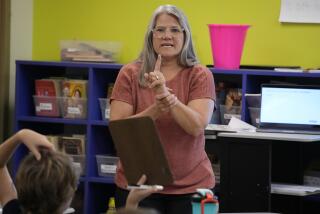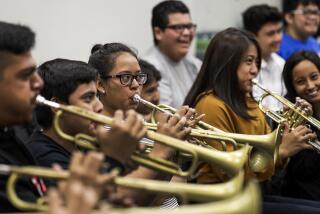Educators Call for Greater Emphasis on Arts in School
- Share via
WASHINGTON — Prominent educators Thursday called for greater emphasis on the arts in school curricula as one of the most effective ways to teach all subject areas--such as math, geography and history--and to better prepare students for the demands of future jobs.
“The arts are the best path to success in the other basics,” said Ramon Cortines, chancellor of the New York City school system.
His remarks were delivered during the first day of a three-day conference here sponsored by the Getty Center for Education in the Arts. “Beyond the Three Rs: Transforming Education with the Arts” was called to examine the connection between what educators say is needed to improve student learning and what arts education teaches students.
“Arts education today is more than performing music, dance or drama and making a drawing,” said Leilani Lattin Duke, director of the Getty center. “When the arts are taught as a substantive discipline, like science and history, they develop the critical thinking, problem-solving and communications skills most highly prized by employers today.”
Cortines said that one of the best examples in his own professional experience was a visit to a middle school in New York City where students were involved “in an integrated unit that sprang from the art of Joseph Stella and centered on the Brooklyn Bridge.”
“I never saw so much math, science--especially physics--history, reading, writing, speaking, researching going on in the classroom, all through the prism of the arts,” he said. “Students had prints of 17 versions of Stella’s (painting) ‘Brooklyn Bridge.’ ”
He said that the students compared the Stella works with each other and with a Currier & Ives print made when the bridge was opened, and they read Walt Whitman and Hart Crane poetry about the bridge.
“They knew about the vision of John Roebling, who designed the bridge, and his son, Washington, who directed the construction after his father died,” Cortines said. “They had interviewed, edited and published the oral histories of grandparents from immigrant families to help them understand (that) the bridge has literal and figurative meaning, that it was a metaphor for a great many of the changes happening in our nation at the time it was built.” Cortines added that the youngsters “had come to think of bridges not just as awesome feats of engineering . . . but as a means of passage from the past to the present to the future. . . . I never cross the Brooklyn Bridge today without thinking of what those students took from that experience.”
Duke said that she believes the arts “are one of the most effective means of integrating all subjects,” and could play an important role today at a time “when subjects are so disconnected.”
“It’s little wonder that kids conclude that none of it makes sense to their lives or to what they’re expected to do when they graduate from high school,” she continued. “The arts--whether visual, theater, music or dance--can bring some cohesion to what is a very fragmented curriculum. His (Cortines’) example is a way of seeing how that can happen.”
The Getty center is an operating program of the J. Paul Getty Trust and is dedicated to improving the quality and status of arts education in the nation’s schools. The Getty trust is a private operating foundation devoted to arts and the humanities.
The conference was the center’s fifth annual meeting. This year’s sessions, which end Saturday, focus on the growing role of arts education in the national education reform movement, and its links to student achievement, interdisciplinary learning, work-force readiness, multicultural education and technology.
More to Read
Sign up for Essential California
The most important California stories and recommendations in your inbox every morning.
You may occasionally receive promotional content from the Los Angeles Times.












